+ Open data
Open data
- Basic information
Basic information
| Entry |  | |||||||||
|---|---|---|---|---|---|---|---|---|---|---|
| Title | Fkbp39 associated nascent 60S class 4 | |||||||||
 Map data Map data | Fkbp39 associated nascent 60S class 4 | |||||||||
 Sample Sample |
| |||||||||
| Function / homology |  Function and homology information Function and homology informationL13a-mediated translational silencing of Ceruloplasmin expression / Formation of a pool of free 40S subunits / GTP hydrolysis and joining of the 60S ribosomal subunit / SRP-dependent cotranslational protein targeting to membrane / Major pathway of rRNA processing in the nucleolus and cytosol / Nonsense Mediated Decay (NMD) independent of the Exon Junction Complex (EJC) / Nonsense Mediated Decay (NMD) enhanced by the Exon Junction Complex (EJC) / rRNA (guanosine-2'-O-)-methyltransferase activity / rRNA (uridine-2'-O-)-methyltransferase activity / rRNA (guanine) methyltransferase activity ...L13a-mediated translational silencing of Ceruloplasmin expression / Formation of a pool of free 40S subunits / GTP hydrolysis and joining of the 60S ribosomal subunit / SRP-dependent cotranslational protein targeting to membrane / Major pathway of rRNA processing in the nucleolus and cytosol / Nonsense Mediated Decay (NMD) independent of the Exon Junction Complex (EJC) / Nonsense Mediated Decay (NMD) enhanced by the Exon Junction Complex (EJC) / rRNA (guanosine-2'-O-)-methyltransferase activity / rRNA (uridine-2'-O-)-methyltransferase activity / rRNA (guanine) methyltransferase activity / maturation of 5.8S rRNA from tricistronic rRNA transcript (SSU-rRNA, 5.8S rRNA, LSU-rRNA) / rRNA methylation / nuclear-transcribed mRNA catabolic process / maturation of 5.8S rRNA /  ribosomal subunit export from nucleus / ribosomal subunit export from nucleus /  ribosomal large subunit binding / protein-RNA complex assembly / preribosome, large subunit precursor / maturation of LSU-rRNA from tricistronic rRNA transcript (SSU-rRNA, 5.8S rRNA, LSU-rRNA) / maturation of LSU-rRNA / ribosomal large subunit binding / protein-RNA complex assembly / preribosome, large subunit precursor / maturation of LSU-rRNA from tricistronic rRNA transcript (SSU-rRNA, 5.8S rRNA, LSU-rRNA) / maturation of LSU-rRNA /  ribosomal large subunit biogenesis / ribosomal large subunit biogenesis /  Transferases; Transferring one-carbon groups; Methyltransferases / Transferases; Transferring one-carbon groups; Methyltransferases /  translation initiation factor activity / assembly of large subunit precursor of preribosome / cytosolic ribosome assembly / translation initiation factor activity / assembly of large subunit precursor of preribosome / cytosolic ribosome assembly /  mitotic spindle / rRNA processing / large ribosomal subunit rRNA binding / mitotic spindle / rRNA processing / large ribosomal subunit rRNA binding /  protein transport / protein transport /  ribosome biogenesis / cytoplasmic translation / cytosolic large ribosomal subunit / negative regulation of translation / ribosome biogenesis / cytoplasmic translation / cytosolic large ribosomal subunit / negative regulation of translation /  rRNA binding / rRNA binding /  ribosome / structural constituent of ribosome / ribosome / structural constituent of ribosome /  cell cycle / cell cycle /  translation / translation /  mRNA binding / mRNA binding /  GTPase activity / GTP binding / GTPase activity / GTP binding /  nucleolus / nucleolus /  RNA binding / zinc ion binding / RNA binding / zinc ion binding /  nucleus / nucleus /  cytosol / cytosol /  cytoplasm cytoplasmSimilarity search - Function | |||||||||
| Biological species |   Schizosaccharomyces pombe (fission yeast) Schizosaccharomyces pombe (fission yeast) | |||||||||
| Method |  single particle reconstruction / single particle reconstruction /  cryo EM / Resolution: 3.1 Å cryo EM / Resolution: 3.1 Å | |||||||||
 Authors Authors | Bilokapic S / Halic M | |||||||||
| Funding support |  United States, 1 items United States, 1 items
| |||||||||
 Citation Citation |  Journal: Mol Cell / Year: 2022 Journal: Mol Cell / Year: 2022Title: Chromatin localization of nucleophosmin organizes ribosome biogenesis. Authors: Ilaria Ugolini / Silvija Bilokapic / Mylene Ferrolino / Josiah Teague / Yinxia Yan / Xuelin Zhou / Ashish Deshmukh / Michael White / Richard W Kriwacki / Mario Halic /   Abstract: Ribosome biogenesis takes place in the nucleolus, a nuclear membrane-less organelle. Although well studied, it remains unknown how nascent ribosomal subunits separate from the central chromatin ...Ribosome biogenesis takes place in the nucleolus, a nuclear membrane-less organelle. Although well studied, it remains unknown how nascent ribosomal subunits separate from the central chromatin compartment and move to the outer granular component, where maturation occurs. We find that the Schizosaccharomyces pombe nucleophosmin-like protein Fkbp39 localizes to rDNA sites encoding the 60S subunit rRNA, and this localization contributes to its specific association with nascent 60S subunits. Fkbp39 dissociates from chromatin to bind nascent 60S subunits, causing the latter to partition away from chromatin and from nascent 40S subunits through liquid-liquid phase separation. In vivo, Fkbp39 binding directs the translocation of nascent 60S subunits toward the nucleophosmin-rich granular component. This process increases the efficiency of 60S subunit assembly, facilitating the incorporation of 60S RNA domain III. Thus, chromatin localization determines the specificity of nucleophosmin in sorting nascent ribosomal subunits and coordinates their movement into specialized assembly compartments within the nucleolus. | |||||||||
| History |
|
- Structure visualization
Structure visualization
| Supplemental images |
|---|
- Downloads & links
Downloads & links
-EMDB archive
| Map data |  emd_24398.map.gz emd_24398.map.gz | 279.6 MB |  EMDB map data format EMDB map data format | |
|---|---|---|---|---|
| Header (meta data) |  emd-24398-v30.xml emd-24398-v30.xml emd-24398.xml emd-24398.xml | 8.4 KB 8.4 KB | Display Display |  EMDB header EMDB header |
| Images |  emd_24398.png emd_24398.png | 39.5 KB | ||
| Archive directory |  http://ftp.pdbj.org/pub/emdb/structures/EMD-24398 http://ftp.pdbj.org/pub/emdb/structures/EMD-24398 ftp://ftp.pdbj.org/pub/emdb/structures/EMD-24398 ftp://ftp.pdbj.org/pub/emdb/structures/EMD-24398 | HTTPS FTP |
-Related structure data
| Related structure data | 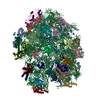 8etcMC 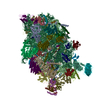 8esqC 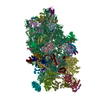 8esrC 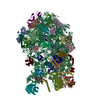 8etgC 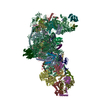 8ethC 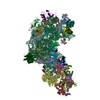 8etiC  8etjC 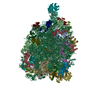 8eugC 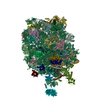 8euiC 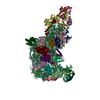 8eupC 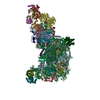 8euyC 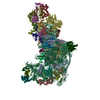 8ev3C C: citing same article ( M: atomic model generated by this map |
|---|---|
| Similar structure data | Similarity search - Function & homology  F&H Search F&H Search |
- Links
Links
| EMDB pages |  EMDB (EBI/PDBe) / EMDB (EBI/PDBe) /  EMDataResource EMDataResource |
|---|---|
| Related items in Molecule of the Month |
- Map
Map
| File |  Download / File: emd_24398.map.gz / Format: CCP4 / Size: 512 MB / Type: IMAGE STORED AS FLOATING POINT NUMBER (4 BYTES) Download / File: emd_24398.map.gz / Format: CCP4 / Size: 512 MB / Type: IMAGE STORED AS FLOATING POINT NUMBER (4 BYTES) | ||||||||||||||||||||
|---|---|---|---|---|---|---|---|---|---|---|---|---|---|---|---|---|---|---|---|---|---|
| Annotation | Fkbp39 associated nascent 60S class 4 | ||||||||||||||||||||
| Voxel size | X=Y=Z: 1.06 Å | ||||||||||||||||||||
| Density |
| ||||||||||||||||||||
| Symmetry | Space group: 1 | ||||||||||||||||||||
| Details | EMDB XML:
|
-Supplemental data
- Sample components
Sample components
-Entire : nascent 60S
| Entire | Name: nascent 60S |
|---|---|
| Components |
|
-Supramolecule #1: nascent 60S
| Supramolecule | Name: nascent 60S / type: complex / ID: 1 / Parent: 0 |
|---|---|
| Source (natural) | Organism:   Schizosaccharomyces pombe (fission yeast) Schizosaccharomyces pombe (fission yeast) |
-Experimental details
-Structure determination
| Method |  cryo EM cryo EM |
|---|---|
 Processing Processing |  single particle reconstruction single particle reconstruction |
| Aggregation state | particle |
- Sample preparation
Sample preparation
| Buffer | pH: 7.2 |
|---|---|
| Vitrification | Cryogen name: ETHANE |
- Electron microscopy
Electron microscopy
| Microscope | FEI TITAN KRIOS |
|---|---|
| Electron beam | Acceleration voltage: 300 kV / Electron source:  FIELD EMISSION GUN FIELD EMISSION GUN |
| Electron optics | Illumination mode: FLOOD BEAM / Imaging mode: BRIGHT FIELD Bright-field microscopy Bright-field microscopy |
| Image recording | Film or detector model: GATAN K3 BIOQUANTUM (6k x 4k) / Average electron dose: 80.0 e/Å2 |
| Experimental equipment |  Model: Titan Krios / Image courtesy: FEI Company |
- Image processing
Image processing
| Initial angle assignment | Type: PROJECTION MATCHING |
|---|---|
| Final angle assignment | Type: PROJECTION MATCHING |
| Final reconstruction | Resolution.type: BY AUTHOR / Resolution: 3.1 Å / Resolution method: FSC 0.143 CUT-OFF / Number images used: 18000 |
 Movie
Movie Controller
Controller
























